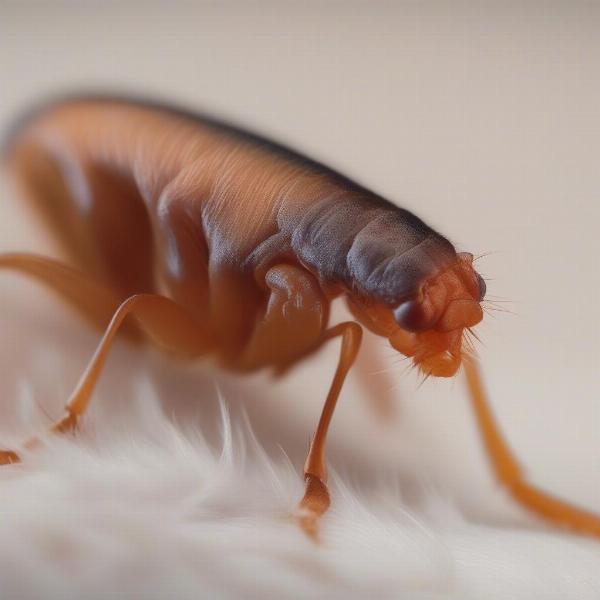Finding a single flea on your dog can be alarming, but it doesn’t necessarily mean a full-blown infestation. However, swift action is crucial to prevent the problem from escalating. This article will guide you through the necessary steps to take after discovering a flea on your furry friend, offering practical advice and expert insights to ensure your dog remains flea-free.
What Does One Flea Mean?
Finding one flea doesn’t always mean your dog is infested, but it’s a definite warning sign. Fleas are prolific breeders, and a single flea can quickly multiply into a serious problem. Even if you’ve only spotted one, it’s highly likely there are more lurking in your dog’s fur, your home, or your yard. Think of it like an iceberg – you only see the tip, but there’s a much larger issue beneath the surface. It’s crucial to act quickly to prevent a full-blown infestation. This includes treating your dog, your home, and potentially your yard to break the flea life cycle.
 Discovering a Flea on Your Dog
Discovering a Flea on Your Dog
Treating Your Dog
There are several effective flea treatments available for dogs, including topical solutions, oral medications, flea collars, and shampoos. Consult your veterinarian to determine the best option for your dog’s age, breed, health status, and lifestyle. It’s essential to follow the instructions carefully and use the correct dosage.
Choosing the Right Flea Treatment
The most effective flea treatment will vary depending on your dog and their specific needs. Some dogs might be sensitive to certain chemicals, while others may have underlying health conditions that require a specific type of treatment.
- Topical solutions: These are applied directly to your dog’s skin, usually on the back of the neck. They typically kill adult fleas and can provide protection for several weeks.
- Oral medications: These are pills or chewables that kill fleas internally. They are often more convenient than topical solutions and can be highly effective.
- Flea collars: These collars release insecticide to kill fleas and can provide long-lasting protection. However, some dogs may be sensitive to the chemicals in the collar.
- Flea shampoos: These shampoos can kill fleas on contact but don’t provide long-term protection. They are best used in conjunction with other flea treatments.
Treating Your Home
Even if you only found one flea on your dog, it’s crucial to treat your home to eliminate any eggs or larvae that might be present. This includes thoroughly vacuuming all carpets, rugs, and upholstery, paying particular attention to areas where your dog spends the most time. Wash your dog’s bedding, blankets, and any other washable items in hot water. Consider using a flea spray or fogger for your home, following the instructions carefully.
Preventing Future Infestations
Regularly grooming your dog with a flea comb can help you detect fleas early and prevent infestations. Vacuuming frequently and washing your dog’s bedding regularly can also help to minimize the risk of fleas. Maintaining a clean and tidy yard can also deter fleas.
“Regular preventative measures are crucial in maintaining a flea-free environment for your dog,” advises Dr. Emily Carter, DVM, a veterinary specialist in parasitology. “Consistent grooming, cleaning, and appropriate flea treatments are the cornerstone of effective flea control.”
Conclusion
Finding one flea on your dog should be a call to action. While it might not seem like a big deal, a single flea can quickly lead to a significant infestation. By taking proactive steps to treat your dog and your home, you can effectively eliminate fleas and prevent future problems. Remember to consult your veterinarian for the most appropriate flea treatment for your dog. Regular preventative measures are key to keeping your furry friend flea-free and happy.
FAQ
- Is one flea a sign of an infestation? While not always indicative of a full-blown infestation, a single flea is a strong warning sign. It warrants immediate action to prevent a larger problem.
- What should I do if I find one flea on my dog? Treat your dog with a suitable flea treatment, thoroughly clean your home, and consult your veterinarian.
- How can I prevent fleas in the future? Regular grooming, vacuuming, washing your dog’s bedding, and using preventative flea treatments are essential.
- What is the best flea treatment for my dog? Consult your veterinarian to determine the most appropriate flea treatment based on your dog’s specific needs.
- How often should I treat my dog for fleas? Follow your veterinarian’s recommendations and the instructions on the flea treatment product.
- Can fleas transmit diseases? Yes, fleas can transmit diseases to both dogs and humans.
- How do I know if my home is infested with fleas? Signs include seeing fleas on your dog, finding flea dirt (small black specks), and experiencing flea bites yourself.
ILM Dog is a leading international pet website dedicated to providing expert advice on dog care and wellbeing. We offer comprehensive resources on dog breeds, health, training, nutrition, grooming, and much more. From choosing the right breed to understanding your dog’s health needs, ILM Dog is your trusted source for reliable and practical information. Contact us today to learn more about our services and how we can help you provide the best possible care for your canine companion. Email: [email protected], Phone: +44 20-3965-8624. Visit ILM Dog for expert advice on all aspects of dog care.